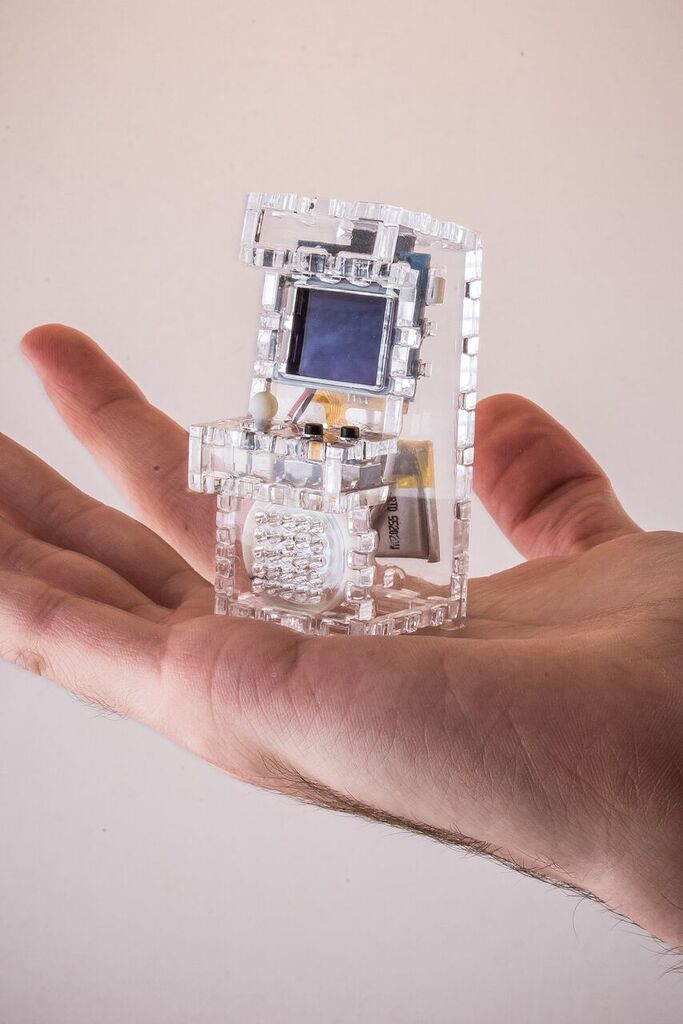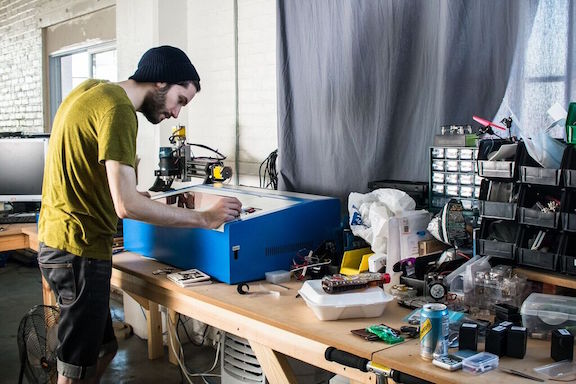Consumers love cute stuff. Don't believe me? A French designer has raised over $1.5 million for a security camera that looks like an owl. It's not technologically groundbreaking, but the thing is so adorable it's pretty much gone viral on every social media platform out there. The Tiny Arcade capitalizes on the general public's love of all things twee and adds a bit nostalgia, which makes for a potent combination. We asked Ken Burns, the creator of Tiny Arcade, for details on his successful invention.

What’s the inspiration behind Tiny Arcade?
The Tiny Arcade came as an outgrowth of our TinyScreen product that we launched last year, which is a small OLED screen that can fit onto our standard TinyDuino. We loved the flexibility this gave users to put a small display in places not before easily possible, like to create their own wearables or add a display to a small project, and most of our examples were based around those ideas, like a DIY smart watch. Almost as a goof, we did a small video game console using the TinyScreen, which turned out to be the biggest hit of all the things we did.
In the spring of 2015, we got the idea to do a Tiny Arcade cabinet, and set our designer friend (Jason Bannister of Mechanimal.com) off on this, and he came back with a pretty amazing 3D printed arcade cabinet based around our circuitry. This was a one-off unit that we showed off at various shows, like Maker Faires across the US, and it was extremely popular. People started asking how to make their own and how to buy one, so we determined that this was something people really wanted and we worked on making it into something affordable and doable.
Since we’re hardware geeks, could you go please go into detail with your hardware?
We’re hardware geeks here, too! Our main TinyDuino processor board is basically the same as an Arduino Uno, just shrunk down to the size of a quarter. We were running into memory size limits and processor speed issues with this processor when playing games, so we’ve redesigned this to be based around a 32-bit ARM Cortex-M0 processor (the same as in the new Arduino Zero), with much more horsepower and memory (256KB Flash, 32KB RAM, 48MHz clock rate). We’ve also combined all the core functions (Processor, USB, Battery Charging and the OLED Screen) onto a single board to help reduce size and cost. We call this our new TinyScreen+ board, and it’s still compatible with all our other expansion boards that we’ve released before.
We’ve also designed a small flex board that connects in with a microSD card expansion slot, speaker drivers, an analog joystick and two push buttons.
Why would you make them so tiny?
It’s kind of our thing!
Actually there are other mini arcades out there, based around a Raspberry Pi or something similar, but if you look at their cases they are somewhat kludgy and don’t really look like an old school arcade cabinet. This is mostly due to the size of the screen and electronics: if they made this to scale it would just be too big to be useful.
We really wanted to make it to scale, like a real arcade cabinet, but something you could hold in your hand and play, or leave on your desk at work and not take up a lot of space. This is a big reason we include a battery with it, so you can pick it up to play it and take it with you.

What are some games you’re hoping developers will contribute to your open source library?
We really want to round out the offering of classic games that people are familiar with. We already have some core games like Asteroids and Space Invaders (which were both developed by open source developers who bought the TinyScreen last year), but being an old school nerd, I’d love to see a Pacman like game, Q-bert would be great! And Galaga, my absolute favorite.
What’s your audience—are you aimed at older nerds or younger ones?
It’s pretty much everyone – young kids immediately gravitate towards the games when we show it off, and the DIY Kit aspect that we offer makes it a good learning experience to put one together. But we’ve had great feedback from people of my generation that grew up playing games at the arcade. They immediately light up when they see the cabinet and the games that they can play; it takes them back to the old school days. I could definitely see this as a desk toy for a lot of people.
Have you had any manufacturing challenges present themselves so far?
Manufacturing is always a concern, and one that we’ve been through before. When we launched the main TinyDuino project in 2012, we made the decision to do our manufacturing in-house, and bought a Surface-Mount Technology (SMT) production line. So we manufacture all of the circuit assemblies here in our Akron, Ohio facility. There are certain challenges to manufacturing in house, but the investment has been well worth it. We have a wide variety of different products (over 45 different boards), all relatively low volume, and doing manufacturing in house really lets us keep the cost per board down.
The main boards in the Tiny Arcade are built to our same process, so we have no problems producing them. We have two types of cabinets, a laser cut version (either acrylic or wood), and a high-end 3D printed one. The 3D printed ones will be printed with a commercial service like Shapeways (the print is too complicated for a low end Makerbot type 3D printer), and we have a laser cutter to do the wood and acrylic in house.
Any hints as to what your next project might be?
Hmmm…. We’ve got quite a few things on the back burner. The next really big thing likely will be a new robotic platform that makes doing small robotic and RC projects easier, integrating processor, radio, motor and servo drivers into one boards. And it will be tiny of course.

The Tiny Arcade has raised over $50k on Kickstarter and is kind of a perfect stocking stuffer. Their company serves as a reminder that there's big bucks to be made by making something cute. So if you're a designer, consider adding novelty to your next project to attract attention.
